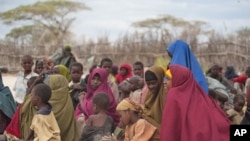World Health Organization officials say Somalia is facing "the huge threat" of a cholera epidemic, and that efforts to contain and control the disease must be intensified. Health officials say overcrowding, bad sanitary conditions and population movements risk spreading the disease rapidly in the famine-stricken country.
The World Health Organization reports a sharp rise in the number of cholera cases in Somalia this year. It says 60 percent of 30 randomly collected samples of acute watery diarrhea taken from more than 4,200 people in the capital Mogadishu, tested positive for cholera.
WHO public health adviser Michel Yao tells VOA all signs indicate the presence of a cholera epidemic.
“In the cholera context, even when one case is confirmed, we can say that there is an epidemic. Now, in Somalia, there has been a kind of regular recurrence of cases of cholera since several years,” he said.
He notes the number of cholera cases is going up at an alarming rate, especially among internally displaced people. Dr. Yao says IDPs account for 39 percent of the positive cases; the other cholera victims were residents of Mogadishu.
The World Health Organization says cholera outbreaks are fueled by the many informal settlements springing up in Somalia, made up of people who left their homes in search of food and other assistance.
Makeshift shelters, poor water and sanitation increases the risk of the spread of cholera, and the WHO says the high number of malnourished children weakened by famine are much more susceptible to waterborne diseases such as acute watery diarrhea.
Dr. Yao tells VOA the cholera situation is very worrisome in Somalia. In some places, he says, three times as many cases are being reported compared to the same period last year.
“So … this is what we fear as the World Health Organization, that the disease can spread within the most vulnerable population in which we have malnourished children, we have displaced population without proper water and sanitation," he said. "What we are saying is that the numbers are increasing, and we have an increased trend in … acute watery diarrhea and cholera. And so this is a huge threat and, what we say, a huge threat of epidemic around targeting the affected population in drought-affected areas in Somalia.”
WHO says aid agencies must scale up their efforts to contain cholera and prevent it from spreading, promptly treating the disease, providing safe water, proper sanitation and health education.
WHO has sent 19 diarrheal disease kits to various places in Somalia. Each kit can treat 100 severe or 400 mild cases. And several other U.N. agencies have pre-positioned supplies to respond to the needs.
Somalia Faces Cholera Epidemic














